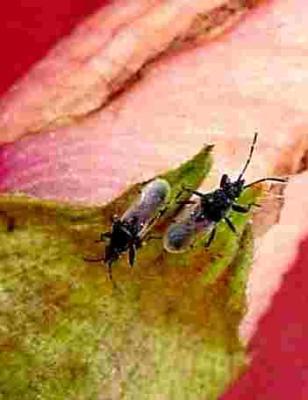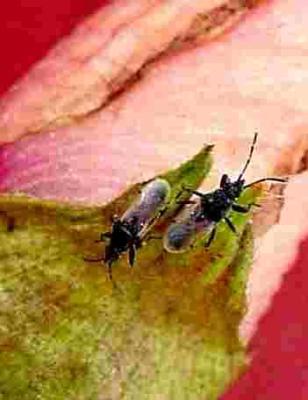

Bugs (Blue bug, cotton lygus, cotton seed bug)
Other bugs feeding on cotton include blue bugs and cotton lygus and the cotton seed bug.
Blue bugs (Calidea degrii, Calidea bohemani)
The adults are large bugs, 8 to 17 mm long by 4-8 mm broad, and strikingly coloured, with red or orange underneath and the upper surface bright metallic blue or green with black spots. They suck the seeds of unopened bolls causing staining of the cotton lint in a similar way as stainer bugs; as a result the development ceases and the boll aborts.
Blue bugs seldom breed on cotton. They usually invade cotton when the bolls are well formed, from other host plants, for instance sorghum, sunflower, castor and many wild hosts such as crotalaria and hibiscus.
Cotton lygus (Taylorilygus vosseleri)
The adult bugs are up to 5 mm long and pale green to light brown in colour. The nymphs are green. Adults and nymphs prefer to suck young leaf buds, flower buds and bolls. The toxic saliva causes the flower buds to turn yellow and drop off. Leaves, which have been attacked in the bud stage, later show a ragged appearance with many irregular holes. The cotton lygus is an early season pest.
Cotton seed bug (Oxycarenus hyalinipennis)
These bugs are small (4 to 6 mm) and blackish in colour. Their wings are transparent. They attack open or damaged pods mainly at the end of the growing season. It is a late season pest, which mainly appears when the bolls have opened. Nymphs and adults suck the seeds. Feeding by large numbers of bugs reduces considerably the germination rate, seed weight and oil quality. The lint is not affected.
- Bugs, in particular adults are difficult to control since they can readily move from neighbouring crops or wild plants into the cotton crop.
- Natural enemies are important in the control of bugs; the most important are parasitic wasps attacking bug eggs; ants, which feed on eggs and nymphs; and various predacious bugs, spiders, birds and parasitic flies.
- If heavy outbreaks of the cottonseed bug occur, the cotton should be picked as soon as the cotton bolls mature.
- Neem products reportedly reduce feeding by some bugs.
- Since bugs are late season pests early sowing and picking is recommended to reduce bug attack.
- Tanzania: pyrethrum formulation with black wattle extract as UV light stabiliser
